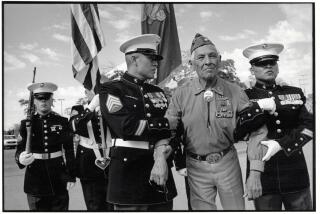FROM RIFLE TO CAMERA : GAME HUNTER’S INNER SAFARI ON ‘EXPLORER’
- Share via
WASHINGTON — It’s somehow fitting that a television series called “Explorer” should be presenting “Man-Eaters of Kumaon.”
This program, produced by the BBC and presented by the National Geographic Society as part of its “Explorer” series, airs Sunday at 5 p.m. WTBS cable.
It breaks relatively fresh ground in TV terms--it’s a wildlife conservation show in docudrama form--while telling the story of a renowned British hunter, Jim Corbett, who became a legend in India, where he could be relied upon to defend villages against the ravages of man-eating tigers.
Ah, but there’s more to the tale than that.
Corbett, played by Frederick Treves, is a man in transition. We find him, in 1929, in his early 50s, enjoying a reputation as the man to call on to fend off crazed tigers or organize a hunt for visiting royalty.
But he is also a man who has seen too many shooters blow away game wantonly, breaking the code of the game-hunting game. There is, after all, a time to kill and a time not to.
You kill if a tiger, wounded or aging, has reached that point in life where the only prey slow enough for it to capture is human. But you don’t kill just for the sake of carpeting your lodge. And you don’t go out and blow 300 ducks out of the sky just because they’re there.
So we find Corbett about to undergo an environmentalist’s conversion. His new religion has its talisman--a friend has given Corbett a camera. Now the man whose rifle is an extension of his arms--he killed his first leopard at age 11--has a new way to shoot game.
And he is a man of the jungle, feels it shrinking and squeezing its inhabitants, the same pressure felt by the tigers.
The production merges the wildlife documentary and dramatic forms, resulting in the first docudrama in the “Explorer” series and creating a rare species for TV.
The film has scenic shots on Indian locations, wildlife footage from National Geographic and that meticulous, if not tedious, British feel to it. The net effect is a combination of a Marlin Perkins safari film, “Out of Africa” and “Masterpiece Theater” rolled into one.
And as with most explorations, getting there was a longer story than the one at hand.
Martin Booth has been stalking Jim Corbett for a long time. Booth, a 42-year-old novelist, was a teen-ager living in East Africa when he was given Corbett’s book, from which the film’s title is taken.
“I was a shooter myself,” said Booth. “Something of a gun boy. There are a lot of animals in Africa, and you shoot them. I shot them and ate them.”
Booth’s infatuation with Corbett continued into the ‘70s, when Booth had his literary agent approach publishers about doing a Corbett biography. No sale. Then how about a TV program? “I originally saw it as a documentary with a talking head--mine, of course,” said Booth. Nice idea, but no thanks.
Enter producer Peter Jones of the BBC natural-history unit.
“I became interested as a matter of curiosity that a number of people who’ve made contributions in natural history and conservation have backgrounds as hunters,” said Jones, recalling John Audubon and Theodore Roosevelt.
“It’s a certain kind of hunter who is fascinated with a certain spot of jungle,” said Jones, “and is the first to detect change in the environment. . . . Corbett was in his late 40s or early 50s when he came to realize that all was not well, especially with the tiger. There was overhunting--of the tiger and its prey, a cutback of the environment.”
Woven into the story of the hunter-turned-naturalist is the element of British social structure.
Despite his local eminence as a sportsman, Corbett was not a privileged Englishman--when he visits an exclusive club to discuss organizing a hunt, he has to sign in.
Corbett and his sister Maggie, played by Anna Cropper, shared the social semi-isolation.
“They were both kept at some kind of distance from British society,” said Jones. “Neither married,” he said, adding that Corbett’s mother discouraged him, and his sister did too.
The film also deals with Corbett’s development as photographer--the still camera is soon replaced by a motion-picture machine. “He was way ahead of his time in terms of natural history filming,” Jones said. Corbett built what amounted to jungle studios, erecting blinds to muffle the noise of his camera to keep it from frightening off his subjects.
“Some of his original footage was found at the British Museum in dusty tins,” Jones said. “The film had shrunk and began to disintegrate in the projector.”
Jones put preservationists to work on the film, and a bit of it is cut into the “Explorer” program.
The film--and the Corbett biography that accompanies its release--close a 20-year concern of Booth’s. The big-game hunter who fascinated him as a boy is now a fully formed figure, realized on tape and paper.
When he started serious research, Booth said, “I was worried that I’d find a charlatan or someone so sanctimonious and pious that he’d stick in your craw. He was a good man. A ruthless businessman, very shrewd; he was very wise with what he did with his money.
“He never married, but he had several affairs--not all with single women. He could be stubborn and deliberately blind. He was fiercely protective of his area--and he regarded it as his . He could be stubbornly dogmatic in his protectiveness. He was modest, very quiet-spoken; he never lost his temper--that was probably his greatest virtue.”
More to Read
The complete guide to home viewing
Get Screen Gab for everything about the TV shows and streaming movies everyone’s talking about.
You may occasionally receive promotional content from the Los Angeles Times.






